Australia's Relationship with its Neighbors: Diplomacy & Strategy
VerifiedAdded on 2023/06/07
|6
|1354
|311
Essay
AI Summary
This essay examines Australia's relationship with its neighboring regions, particularly focusing on China, India, and ASEAN. It highlights the economic and strategic importance of these relationships in the context of a rising China and the evolving dynamics of the Indo-Pacific region. The essay discusses Australia's alliance with the United States, its participation in the Quad group, and its growing ties with India as a counterweight to China's influence. It also emphasizes the significance of Australia's trade and diplomatic relations with ASEAN countries for maintaining regional stability and independence. Furthermore, the essay underscores the importance of a stable relationship with China while addressing issues related to human rights and regional security. The paper concludes by advocating for Australia to leverage its soft power and diplomatic capabilities to promote regional stability and project itself as a vibrant leader in international affairs, all while recognizing opportunities for business and growth in the region.
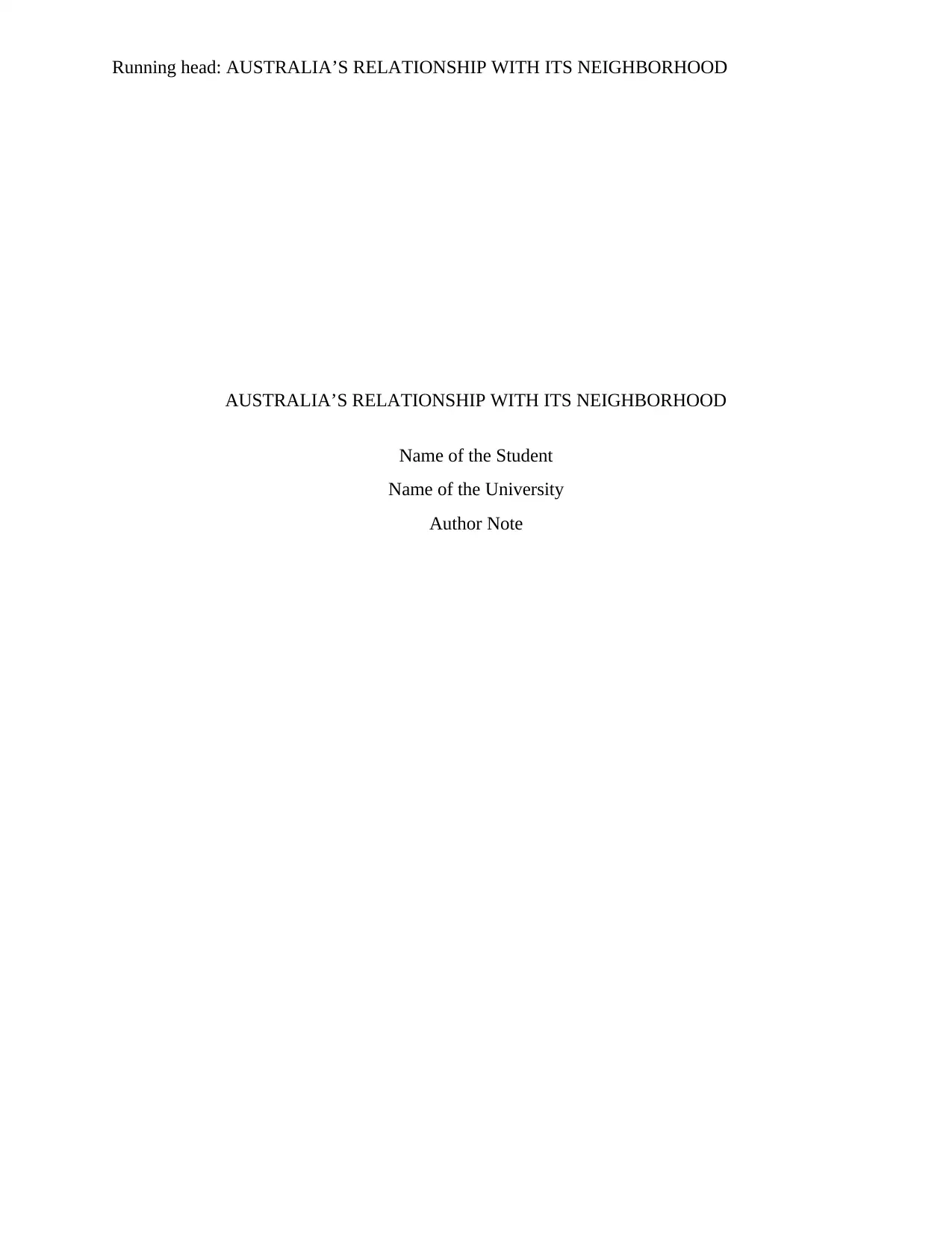
Running head: AUSTRALIA’S RELATIONSHIP WITH ITS NEIGHBORHOOD
AUSTRALIA’S RELATIONSHIP WITH ITS NEIGHBORHOOD
Name of the Student
Name of the University
Author Note
AUSTRALIA’S RELATIONSHIP WITH ITS NEIGHBORHOOD
Name of the Student
Name of the University
Author Note
Paraphrase This Document
Need a fresh take? Get an instant paraphrase of this document with our AI Paraphraser
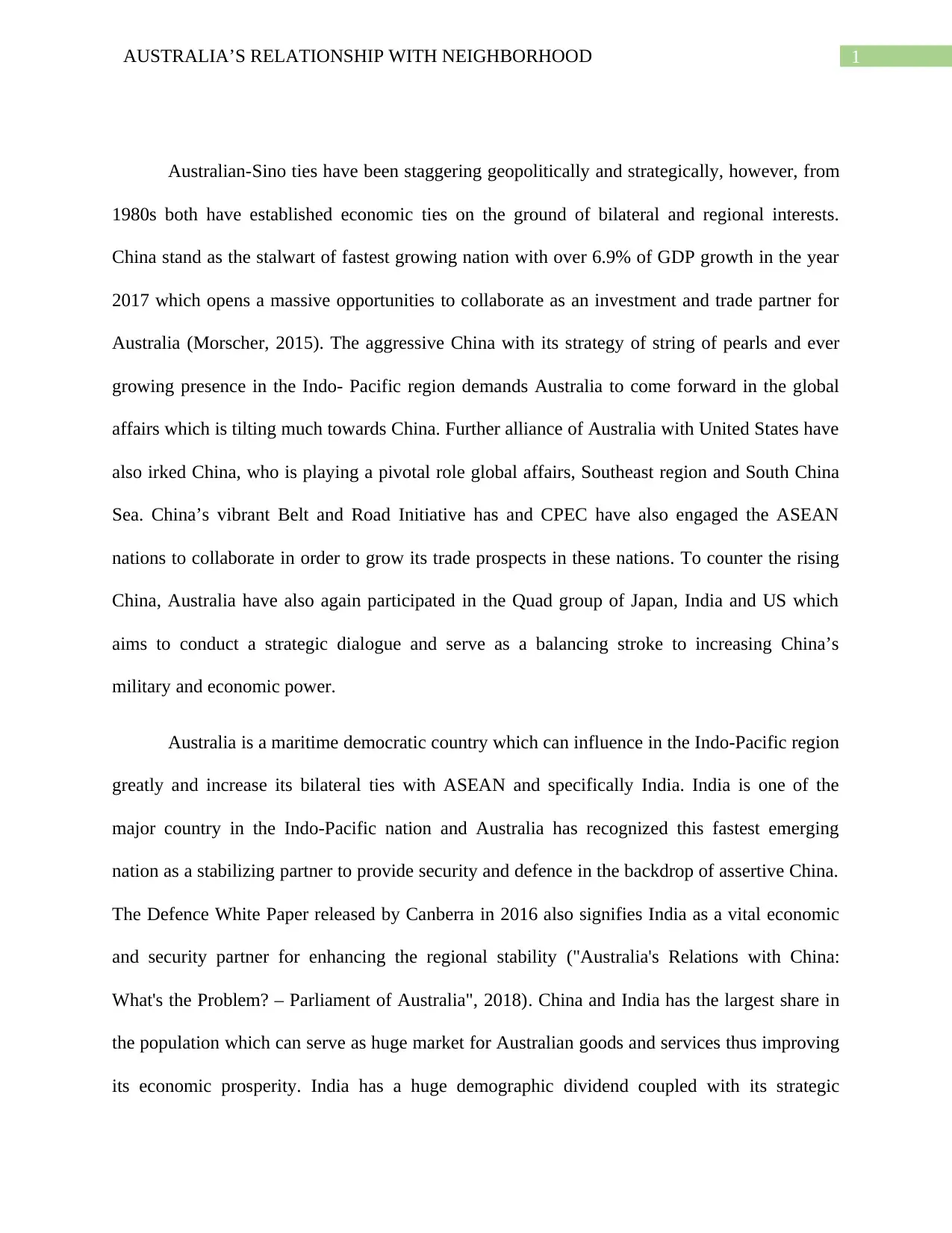
1AUSTRALIA’S RELATIONSHIP WITH NEIGHBORHOOD
Australian-Sino ties have been staggering geopolitically and strategically, however, from
1980s both have established economic ties on the ground of bilateral and regional interests.
China stand as the stalwart of fastest growing nation with over 6.9% of GDP growth in the year
2017 which opens a massive opportunities to collaborate as an investment and trade partner for
Australia (Morscher, 2015). The aggressive China with its strategy of string of pearls and ever
growing presence in the Indo- Pacific region demands Australia to come forward in the global
affairs which is tilting much towards China. Further alliance of Australia with United States have
also irked China, who is playing a pivotal role global affairs, Southeast region and South China
Sea. China’s vibrant Belt and Road Initiative has and CPEC have also engaged the ASEAN
nations to collaborate in order to grow its trade prospects in these nations. To counter the rising
China, Australia have also again participated in the Quad group of Japan, India and US which
aims to conduct a strategic dialogue and serve as a balancing stroke to increasing China’s
military and economic power.
Australia is a maritime democratic country which can influence in the Indo-Pacific region
greatly and increase its bilateral ties with ASEAN and specifically India. India is one of the
major country in the Indo-Pacific nation and Australia has recognized this fastest emerging
nation as a stabilizing partner to provide security and defence in the backdrop of assertive China.
The Defence White Paper released by Canberra in 2016 also signifies India as a vital economic
and security partner for enhancing the regional stability ("Australia's Relations with China:
What's the Problem? – Parliament of Australia", 2018). China and India has the largest share in
the population which can serve as huge market for Australian goods and services thus improving
its economic prosperity. India has a huge demographic dividend coupled with its strategic
Australian-Sino ties have been staggering geopolitically and strategically, however, from
1980s both have established economic ties on the ground of bilateral and regional interests.
China stand as the stalwart of fastest growing nation with over 6.9% of GDP growth in the year
2017 which opens a massive opportunities to collaborate as an investment and trade partner for
Australia (Morscher, 2015). The aggressive China with its strategy of string of pearls and ever
growing presence in the Indo- Pacific region demands Australia to come forward in the global
affairs which is tilting much towards China. Further alliance of Australia with United States have
also irked China, who is playing a pivotal role global affairs, Southeast region and South China
Sea. China’s vibrant Belt and Road Initiative has and CPEC have also engaged the ASEAN
nations to collaborate in order to grow its trade prospects in these nations. To counter the rising
China, Australia have also again participated in the Quad group of Japan, India and US which
aims to conduct a strategic dialogue and serve as a balancing stroke to increasing China’s
military and economic power.
Australia is a maritime democratic country which can influence in the Indo-Pacific region
greatly and increase its bilateral ties with ASEAN and specifically India. India is one of the
major country in the Indo-Pacific nation and Australia has recognized this fastest emerging
nation as a stabilizing partner to provide security and defence in the backdrop of assertive China.
The Defence White Paper released by Canberra in 2016 also signifies India as a vital economic
and security partner for enhancing the regional stability ("Australia's Relations with China:
What's the Problem? – Parliament of Australia", 2018). China and India has the largest share in
the population which can serve as huge market for Australian goods and services thus improving
its economic prosperity. India has a huge demographic dividend coupled with its strategic
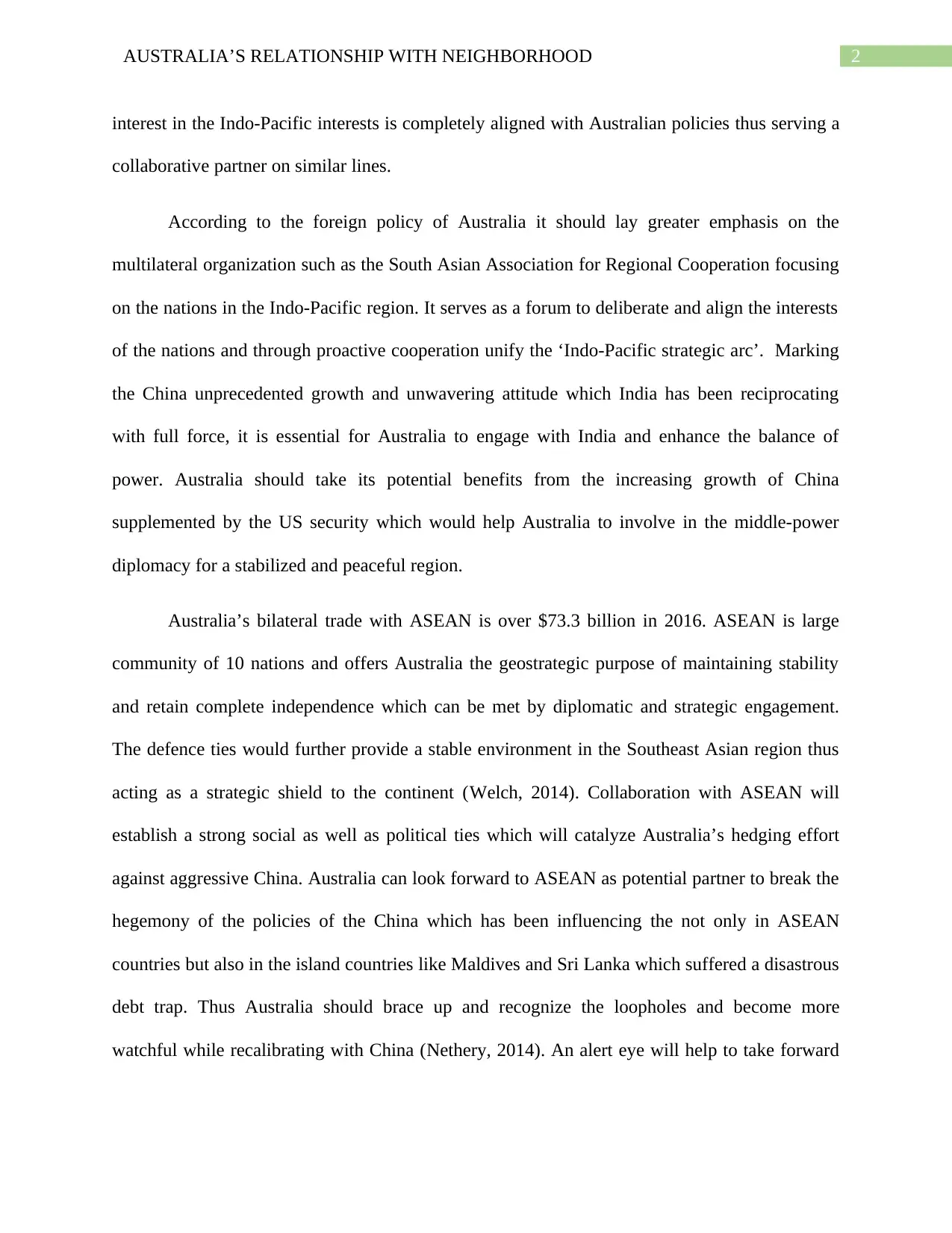
2AUSTRALIA’S RELATIONSHIP WITH NEIGHBORHOOD
interest in the Indo-Pacific interests is completely aligned with Australian policies thus serving a
collaborative partner on similar lines.
According to the foreign policy of Australia it should lay greater emphasis on the
multilateral organization such as the South Asian Association for Regional Cooperation focusing
on the nations in the Indo-Pacific region. It serves as a forum to deliberate and align the interests
of the nations and through proactive cooperation unify the ‘Indo-Pacific strategic arc’. Marking
the China unprecedented growth and unwavering attitude which India has been reciprocating
with full force, it is essential for Australia to engage with India and enhance the balance of
power. Australia should take its potential benefits from the increasing growth of China
supplemented by the US security which would help Australia to involve in the middle-power
diplomacy for a stabilized and peaceful region.
Australia’s bilateral trade with ASEAN is over $73.3 billion in 2016. ASEAN is large
community of 10 nations and offers Australia the geostrategic purpose of maintaining stability
and retain complete independence which can be met by diplomatic and strategic engagement.
The defence ties would further provide a stable environment in the Southeast Asian region thus
acting as a strategic shield to the continent (Welch, 2014). Collaboration with ASEAN will
establish a strong social as well as political ties which will catalyze Australia’s hedging effort
against aggressive China. Australia can look forward to ASEAN as potential partner to break the
hegemony of the policies of the China which has been influencing the not only in ASEAN
countries but also in the island countries like Maldives and Sri Lanka which suffered a disastrous
debt trap. Thus Australia should brace up and recognize the loopholes and become more
watchful while recalibrating with China (Nethery, 2014). An alert eye will help to take forward
interest in the Indo-Pacific interests is completely aligned with Australian policies thus serving a
collaborative partner on similar lines.
According to the foreign policy of Australia it should lay greater emphasis on the
multilateral organization such as the South Asian Association for Regional Cooperation focusing
on the nations in the Indo-Pacific region. It serves as a forum to deliberate and align the interests
of the nations and through proactive cooperation unify the ‘Indo-Pacific strategic arc’. Marking
the China unprecedented growth and unwavering attitude which India has been reciprocating
with full force, it is essential for Australia to engage with India and enhance the balance of
power. Australia should take its potential benefits from the increasing growth of China
supplemented by the US security which would help Australia to involve in the middle-power
diplomacy for a stabilized and peaceful region.
Australia’s bilateral trade with ASEAN is over $73.3 billion in 2016. ASEAN is large
community of 10 nations and offers Australia the geostrategic purpose of maintaining stability
and retain complete independence which can be met by diplomatic and strategic engagement.
The defence ties would further provide a stable environment in the Southeast Asian region thus
acting as a strategic shield to the continent (Welch, 2014). Collaboration with ASEAN will
establish a strong social as well as political ties which will catalyze Australia’s hedging effort
against aggressive China. Australia can look forward to ASEAN as potential partner to break the
hegemony of the policies of the China which has been influencing the not only in ASEAN
countries but also in the island countries like Maldives and Sri Lanka which suffered a disastrous
debt trap. Thus Australia should brace up and recognize the loopholes and become more
watchful while recalibrating with China (Nethery, 2014). An alert eye will help to take forward
⊘ This is a preview!⊘
Do you want full access?
Subscribe today to unlock all pages.

Trusted by 1+ million students worldwide
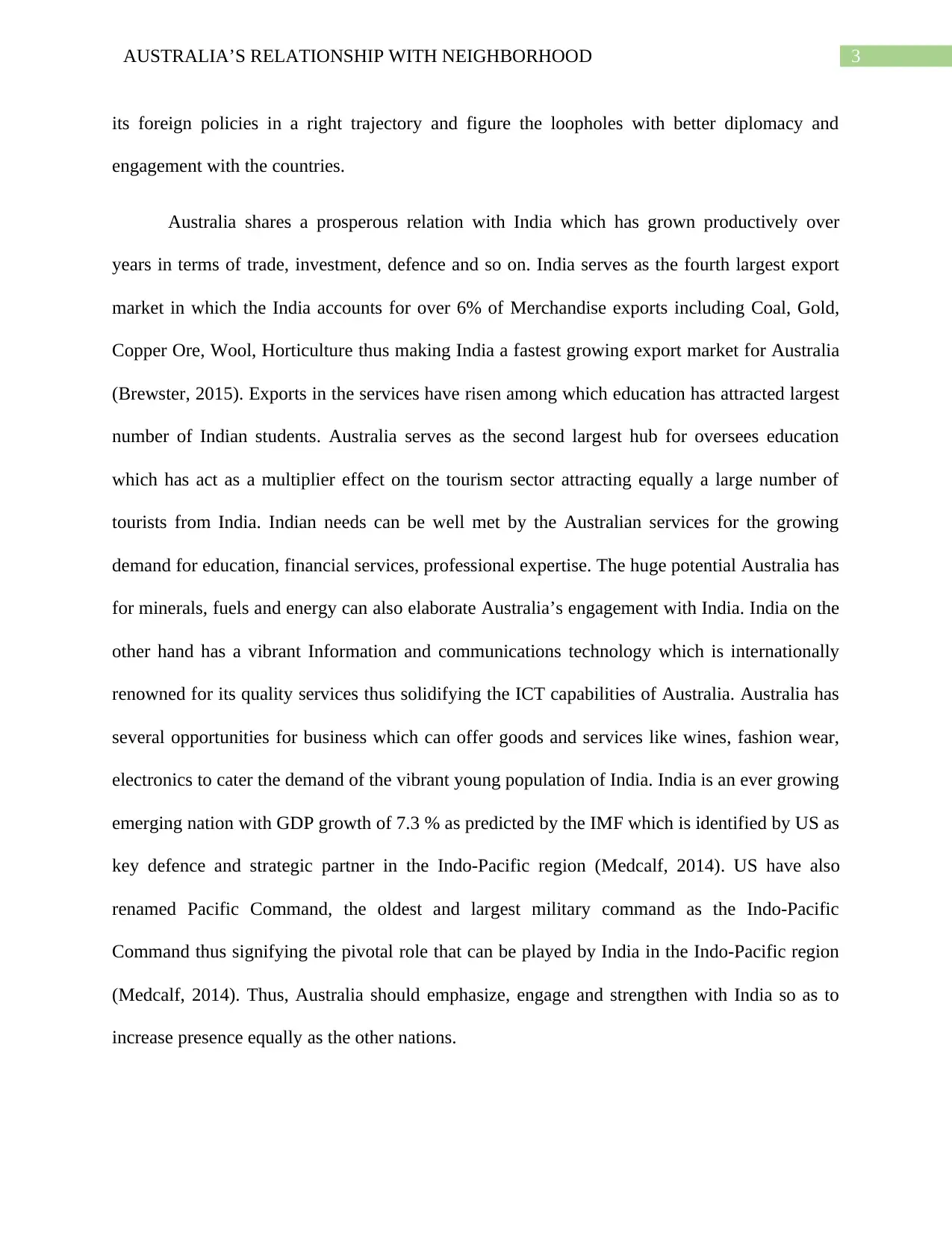
3AUSTRALIA’S RELATIONSHIP WITH NEIGHBORHOOD
its foreign policies in a right trajectory and figure the loopholes with better diplomacy and
engagement with the countries.
Australia shares a prosperous relation with India which has grown productively over
years in terms of trade, investment, defence and so on. India serves as the fourth largest export
market in which the India accounts for over 6% of Merchandise exports including Coal, Gold,
Copper Ore, Wool, Horticulture thus making India a fastest growing export market for Australia
(Brewster, 2015). Exports in the services have risen among which education has attracted largest
number of Indian students. Australia serves as the second largest hub for oversees education
which has act as a multiplier effect on the tourism sector attracting equally a large number of
tourists from India. Indian needs can be well met by the Australian services for the growing
demand for education, financial services, professional expertise. The huge potential Australia has
for minerals, fuels and energy can also elaborate Australia’s engagement with India. India on the
other hand has a vibrant Information and communications technology which is internationally
renowned for its quality services thus solidifying the ICT capabilities of Australia. Australia has
several opportunities for business which can offer goods and services like wines, fashion wear,
electronics to cater the demand of the vibrant young population of India. India is an ever growing
emerging nation with GDP growth of 7.3 % as predicted by the IMF which is identified by US as
key defence and strategic partner in the Indo-Pacific region (Medcalf, 2014). US have also
renamed Pacific Command, the oldest and largest military command as the Indo-Pacific
Command thus signifying the pivotal role that can be played by India in the Indo-Pacific region
(Medcalf, 2014). Thus, Australia should emphasize, engage and strengthen with India so as to
increase presence equally as the other nations.
its foreign policies in a right trajectory and figure the loopholes with better diplomacy and
engagement with the countries.
Australia shares a prosperous relation with India which has grown productively over
years in terms of trade, investment, defence and so on. India serves as the fourth largest export
market in which the India accounts for over 6% of Merchandise exports including Coal, Gold,
Copper Ore, Wool, Horticulture thus making India a fastest growing export market for Australia
(Brewster, 2015). Exports in the services have risen among which education has attracted largest
number of Indian students. Australia serves as the second largest hub for oversees education
which has act as a multiplier effect on the tourism sector attracting equally a large number of
tourists from India. Indian needs can be well met by the Australian services for the growing
demand for education, financial services, professional expertise. The huge potential Australia has
for minerals, fuels and energy can also elaborate Australia’s engagement with India. India on the
other hand has a vibrant Information and communications technology which is internationally
renowned for its quality services thus solidifying the ICT capabilities of Australia. Australia has
several opportunities for business which can offer goods and services like wines, fashion wear,
electronics to cater the demand of the vibrant young population of India. India is an ever growing
emerging nation with GDP growth of 7.3 % as predicted by the IMF which is identified by US as
key defence and strategic partner in the Indo-Pacific region (Medcalf, 2014). US have also
renamed Pacific Command, the oldest and largest military command as the Indo-Pacific
Command thus signifying the pivotal role that can be played by India in the Indo-Pacific region
(Medcalf, 2014). Thus, Australia should emphasize, engage and strengthen with India so as to
increase presence equally as the other nations.
Paraphrase This Document
Need a fresh take? Get an instant paraphrase of this document with our AI Paraphraser
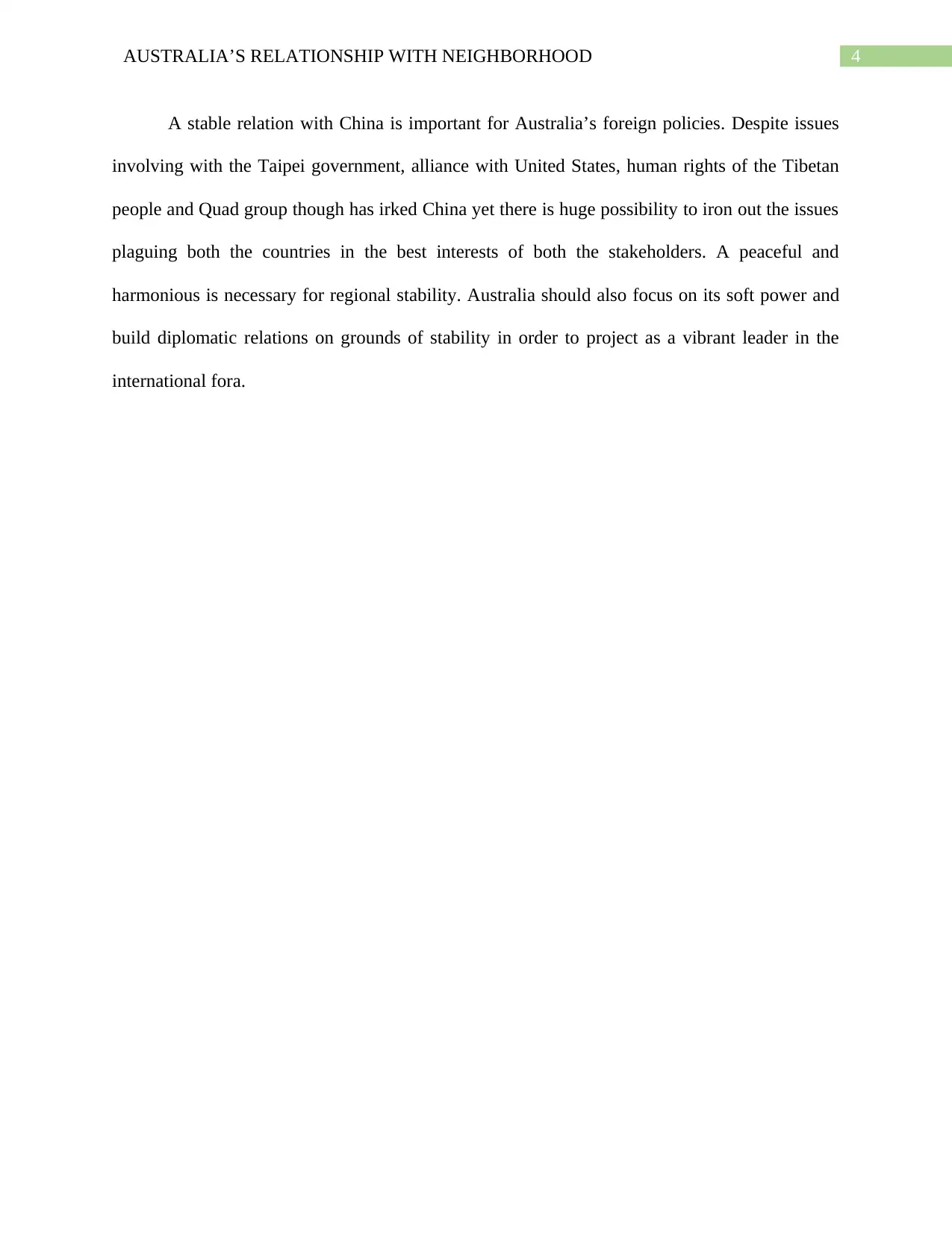
4AUSTRALIA’S RELATIONSHIP WITH NEIGHBORHOOD
A stable relation with China is important for Australia’s foreign policies. Despite issues
involving with the Taipei government, alliance with United States, human rights of the Tibetan
people and Quad group though has irked China yet there is huge possibility to iron out the issues
plaguing both the countries in the best interests of both the stakeholders. A peaceful and
harmonious is necessary for regional stability. Australia should also focus on its soft power and
build diplomatic relations on grounds of stability in order to project as a vibrant leader in the
international fora.
A stable relation with China is important for Australia’s foreign policies. Despite issues
involving with the Taipei government, alliance with United States, human rights of the Tibetan
people and Quad group though has irked China yet there is huge possibility to iron out the issues
plaguing both the countries in the best interests of both the stakeholders. A peaceful and
harmonious is necessary for regional stability. Australia should also focus on its soft power and
build diplomatic relations on grounds of stability in order to project as a vibrant leader in the
international fora.
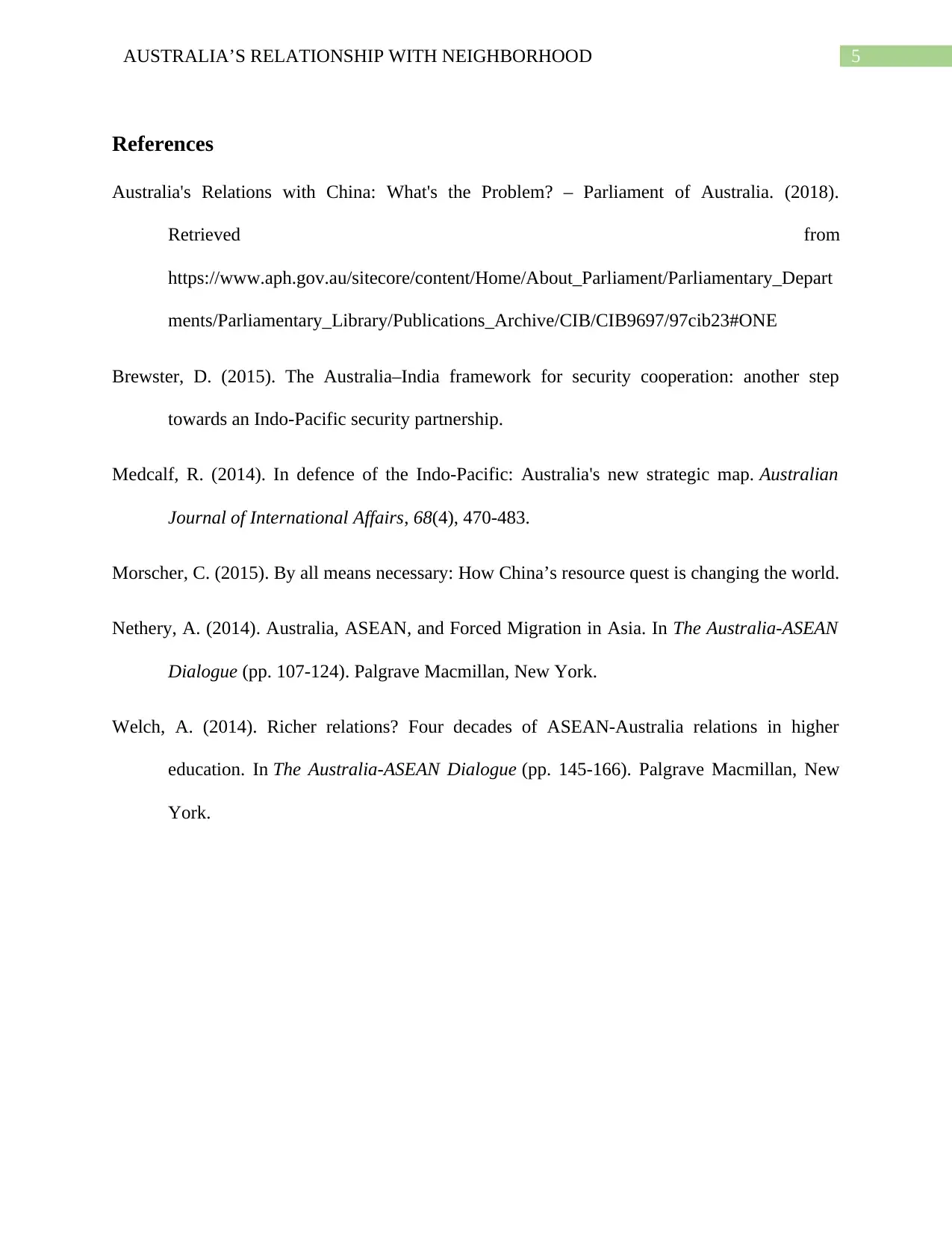
5AUSTRALIA’S RELATIONSHIP WITH NEIGHBORHOOD
References
Australia's Relations with China: What's the Problem? – Parliament of Australia. (2018).
Retrieved from
https://www.aph.gov.au/sitecore/content/Home/About_Parliament/Parliamentary_Depart
ments/Parliamentary_Library/Publications_Archive/CIB/CIB9697/97cib23#ONE
Brewster, D. (2015). The Australia–India framework for security cooperation: another step
towards an Indo-Pacific security partnership.
Medcalf, R. (2014). In defence of the Indo-Pacific: Australia's new strategic map. Australian
Journal of International Affairs, 68(4), 470-483.
Morscher, C. (2015). By all means necessary: How China’s resource quest is changing the world.
Nethery, A. (2014). Australia, ASEAN, and Forced Migration in Asia. In The Australia-ASEAN
Dialogue (pp. 107-124). Palgrave Macmillan, New York.
Welch, A. (2014). Richer relations? Four decades of ASEAN-Australia relations in higher
education. In The Australia-ASEAN Dialogue (pp. 145-166). Palgrave Macmillan, New
York.
References
Australia's Relations with China: What's the Problem? – Parliament of Australia. (2018).
Retrieved from
https://www.aph.gov.au/sitecore/content/Home/About_Parliament/Parliamentary_Depart
ments/Parliamentary_Library/Publications_Archive/CIB/CIB9697/97cib23#ONE
Brewster, D. (2015). The Australia–India framework for security cooperation: another step
towards an Indo-Pacific security partnership.
Medcalf, R. (2014). In defence of the Indo-Pacific: Australia's new strategic map. Australian
Journal of International Affairs, 68(4), 470-483.
Morscher, C. (2015). By all means necessary: How China’s resource quest is changing the world.
Nethery, A. (2014). Australia, ASEAN, and Forced Migration in Asia. In The Australia-ASEAN
Dialogue (pp. 107-124). Palgrave Macmillan, New York.
Welch, A. (2014). Richer relations? Four decades of ASEAN-Australia relations in higher
education. In The Australia-ASEAN Dialogue (pp. 145-166). Palgrave Macmillan, New
York.
⊘ This is a preview!⊘
Do you want full access?
Subscribe today to unlock all pages.

Trusted by 1+ million students worldwide
1 out of 6
Related Documents
Your All-in-One AI-Powered Toolkit for Academic Success.
+13062052269
info@desklib.com
Available 24*7 on WhatsApp / Email
![[object Object]](/_next/static/media/star-bottom.7253800d.svg)
Unlock your academic potential
Copyright © 2020–2026 A2Z Services. All Rights Reserved. Developed and managed by ZUCOL.





